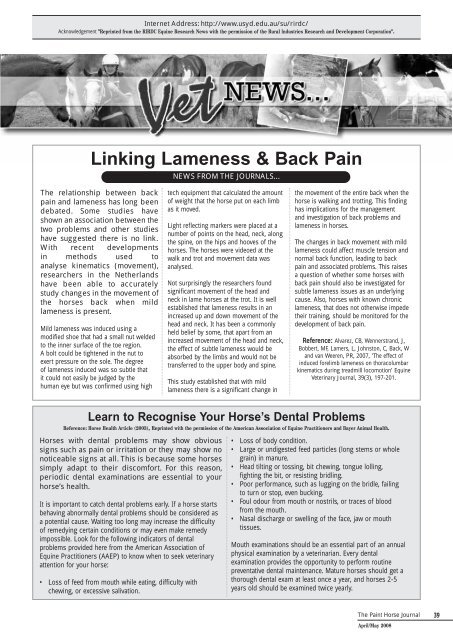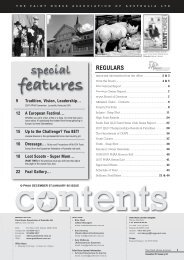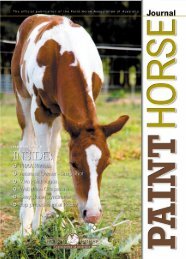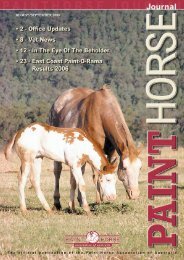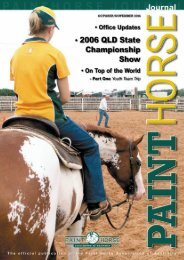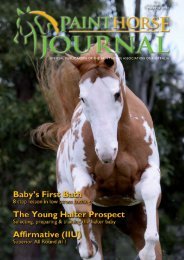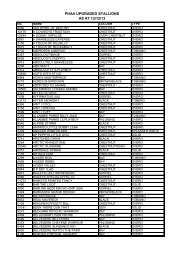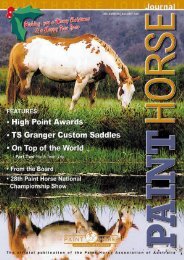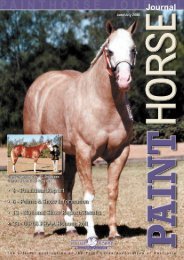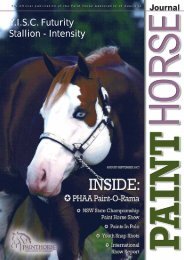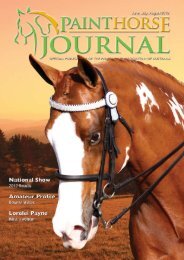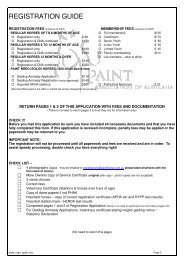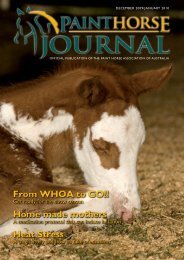Acres of Clover ⢠Photo by: Stefan & Barbara Wielebinski
Acres of Clover ⢠Photo by: Stefan & Barbara Wielebinski
Acres of Clover ⢠Photo by: Stefan & Barbara Wielebinski
You also want an ePaper? Increase the reach of your titles
YUMPU automatically turns print PDFs into web optimized ePapers that Google loves.
Internet Address: http://www.usyd.edu.au/su/rirdc/<br />
Acknowledgement "Reprinted from the RIRDC Equine Research News with the permission <strong>of</strong> the Rural Industries Research and Development Corporation".<br />
Linking Lameness & Back Pain<br />
NEWS FROM THE JOURNALS...<br />
The relationship between back<br />
pain and lameness has long been<br />
debated. Some studies have<br />
shown an association between the<br />
two problems and other studies<br />
have suggested there is no link.<br />
With recent developments<br />
in methods used to<br />
analyse kinematics (movement),<br />
researchers in the Netherlands<br />
have been able to accurately<br />
study changes in the movement <strong>of</strong><br />
the horses back when mild<br />
lameness is present.<br />
Mild lameness was induced using a<br />
modified shoe that had a small nut welded<br />
to the inner surface <strong>of</strong> the toe region.<br />
A bolt could be tightened in the nut to<br />
exert pressure on the sole. The degree<br />
<strong>of</strong> lameness induced was so subtle that<br />
it could not easily be judged <strong>by</strong> the<br />
human eye but was confirmed using high<br />
tech equipment that calculated the amount<br />
<strong>of</strong> weight that the horse put on each limb<br />
as it moved.<br />
Light reflecting markers were placed at a<br />
number <strong>of</strong> points on the head, neck, along<br />
the spine, on the hips and hooves <strong>of</strong> the<br />
horses. The horses were videoed at the<br />
walk and trot and movement data was<br />
analysed.<br />
Not surprisingly the researchers found<br />
significant movement <strong>of</strong> the head and<br />
neck in lame horses at the trot. It is well<br />
established that lameness results in an<br />
increased up and down movement <strong>of</strong> the<br />
head and neck. It has been a commonly<br />
held belief <strong>by</strong> some, that apart from an<br />
increased movement <strong>of</strong> the head and neck,<br />
the effect <strong>of</strong> subtle lameness would be<br />
absorbed <strong>by</strong> the limbs and would not be<br />
transferred to the upper body and spine.<br />
This study established that with mild<br />
lameness there is a significant change in<br />
the movement <strong>of</strong> the entire back when the<br />
horse is walking and trotting. This finding<br />
has implications for the management<br />
and investigation <strong>of</strong> back problems and<br />
lameness in horses.<br />
The changes in back movement with mild<br />
lameness could affect muscle tension and<br />
normal back function, leading to back<br />
pain and associated problems. This raises<br />
a question <strong>of</strong> whether some horses with<br />
back pain should also be investigated for<br />
subtle lameness issues as an underlying<br />
cause. Also, horses with known chronic<br />
lameness, that does not otherwise impede<br />
their training, should be monitored for the<br />
development <strong>of</strong> back pain.<br />
Reference: Alvarez, CB, Wennerstrand, J,<br />
Bobbert, MF, Lamers, L, Johnston, C, Back, W<br />
and van Weeren, PR, 2007, 'The effect <strong>of</strong><br />
induced forelimb lameness on thoracolumbar<br />
kinematics during treadmill locomotion' Equine<br />
Veterinary Journal, 39(3), 197-201.<br />
Learn to Recognise Your Horse’s Dental Problems<br />
Reference: Horse Health Article (2003), Reprinted with the permission <strong>of</strong> the American Association <strong>of</strong> Equine Practitioners and Bayer Animal Health.<br />
Horses with dental problems may show obvious<br />
signs such as pain or irritation or they may show no<br />
noticeable signs at all. This is because some horses<br />
simply adapt to their discomfort. For this reason,<br />
periodic dental examinations are essential to your<br />
horse’s health.<br />
It is important to catch dental problems early. If a horse starts<br />
behaving abnormally dental problems should be considered as<br />
a potential cause. Waiting too long may increase the difficulty<br />
<strong>of</strong> remedying certain conditions or may even make remedy<br />
impossible. Look for the following indicators <strong>of</strong> dental<br />
problems provided here from the American Association <strong>of</strong><br />
Equine Practitioners (AAEP) to know when to seek veterinary<br />
attention for your horse:<br />
• Loss <strong>of</strong> feed from mouth while eating, difficulty with<br />
chewing, or excessive salivation.<br />
• Loss <strong>of</strong> body condition.<br />
• Large or undigested feed particles (long stems or whole<br />
grain) in manure.<br />
• Head tilting or tossing, bit chewing, tongue lolling,<br />
fighting the bit, or resisting bridling.<br />
• Poor performance, such as lugging on the bridle, failing<br />
to turn or stop, even bucking.<br />
• Foul odour from mouth or nostrils, or traces <strong>of</strong> blood<br />
from the mouth.<br />
• Nasal discharge or swelling <strong>of</strong> the face, jaw or mouth<br />
tissues.<br />
Mouth examinations should be an essential part <strong>of</strong> an annual<br />
physical examination <strong>by</strong> a veterinarian. Every dental<br />
examination provides the opportunity to perform routine<br />
preventative dental maintenance. Mature horses should get a<br />
thorough dental exam at least once a year, and horses 2-5<br />
years old should be examined twice yearly.<br />
The Paint Horse Journal 39<br />
April/May 2008


